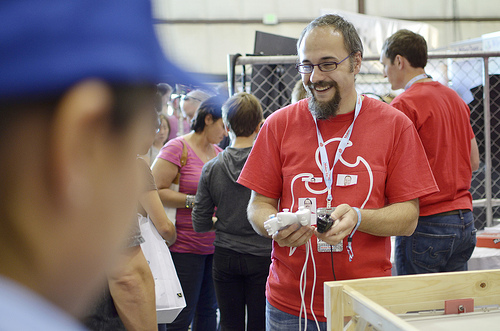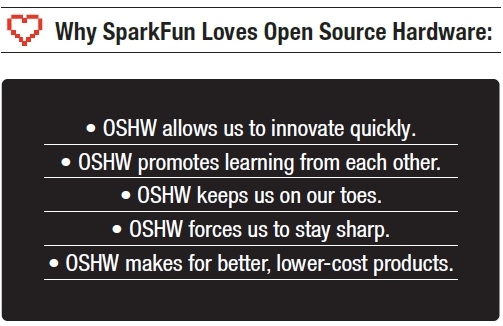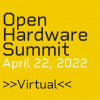As you know, SparkFun is happy to spread the gospel of open source in any way we can. This is our third year as a sponsor of the annual Open Hardware Summit in New York City, which this year takes place on September 27. The summit, organized by our friends at the Open Source Hardware Association (OSHWA), is the world's first comprehensive conference on open hardware -- something we're obviously pretty stoked on. This year, our own Mike Hord is going as a speaker!

Here's Mike, repping SparkFun like a pro in all his homemade motorized t-shirt glory
Mike will be talking about an issue that affects a lot of open hardware creators and suppliers, including us: FCC regulation. At SparkFun, we believe it's absolutely imperative to make sure our products are approved and don't cause harmful radio interference, in order to keep both ourselves and our customers out of federal trouble, and to keep the radio spectrum safe.
However, it's easy to see how one person or a small group experimenting with open source electronics might see FCC testing and frequency approval as an expensive and unnecessary hoop to jump through. Mike will attempt to dispel some misconceptions about the legalities of OSHW in the United States with respect to FCC authorization to sell, in order to preserve and protect the radio spectrum that we all increasingly rely on for our work and play. Recognizing the importance of federal regulation will help legitimize the open hardware movement and ease the ability to share the radio spectrum openly and equally.
Mike is among a wide range of speakers at the summit who will represent industry, academia and the DIY community. Talks and panel discussions will cover a wide range of subjects from electronics and mechanics, to related fields such as digital fabrication, fashion technology, self-quantification devices, education, manufacturing, design, business, and law. It's a fascinating and important event for anyone interested in learning more about or participating in the open source movement.

And now, we have good news and bad news. Which do you want first? Good news? Ok: The summit has sold out! People are pumped about open source! And now the bad news: The summit has sold out. But there is still hope! Tickets are still available as part of the Supporter-level sponsorship package, so if you or your company want to support the summit and head to New York, check out their options here!
In the meantime, SparkFun will be getting ready for the summit and will continue to support OSHWA and the conference, and be an active participant in the open source community! And if you go to the summit, be sure to check out Mike's talk and high five him afterward.








I agree with Andrew, KC6ETE here. I design low power radios and embedded systems professionally. I have seen in the small shops, an attitude of "that doesn't apply to me", or "This isn't a transmitter so I don't need to do the testing". :( If you're going to sell it, and it has a clock > 9kHz, and it's not a digital watch, then you'll at least need radiated emissions. If you intentionally transmit, then you need more testing.
Some labs do charge a fortune for such testing, and when there's a problem you get a blank stare and a big bill. For those in the Boulder area, EMI Testlabs does inexpensive radiated and conducted tests, and when you hit a problem, Dennis can offer very good input on how to deal with it. He likes working with the little guys. His testing is done indoors inside a GTEM cell, so weather isn't a factor.
Few designers in my experience, do enough up front with intelligent PCB layout and bypass design. They throw ferrites and shield cans and multilayer boards at the problem. It is actually pretty easy to do quiet designs on two layer boards in plastic enclosures, without spending any extra money on "fixes". I'm very happy to say that our most frequent comment at testing is "Are you sure that thing is on?"
Actually, I'm at this moment testing a few products here at EMITestlab.com We got another case of "Is that thing on" :) Dennis says "A few hundred bucks will give you a couple of scans from 30M to 1Ghz, that correlate to NIST".
The misconception is that it's really hard to pass part 15 with common micro controllers and RF links. It can be, if your layout is bad, and you are using edges that are much harder than you need.
BTW Ben, the fine for products that violate part 15 can be $10k per unit per day, plus recall and confiscation of non-compliant stock. CE is worse, and can include jail time.
The "Ham Nube" you were talking about above, is an extra class licensee, as I am. A lot of RF and embedded systems guys are also hams. Without those pesky FCC/CE requirements, you probably wouldn't be able to use any of the radio spectrum in a constructive way.
From one of your amateur radio op customers, thank you for being responsible about not causing more RF pollution. Interference can become stressful on both the interfering and interfered-with sides. Less interference = better world for everyone!
Dear Ham nube, plueeese get a clue. If as you suggest, the FCC only required module level compliance for intentional rf transmitters to avoid "causing rf pollution", that might be reasonable, but if I want to use ANY micro-controller to calculate PI and blink the result on an LED powered by a hearing aid battery, I am required to spend $10,000.00 USD for testing, and if I fix a bug in the software, I'm expected to go back and spend $10,000.00 again.
For example: Rasberry PI is NOT an intentional transmitter and can be powered by an AA battery - are you really huddled into a fetal position with anxiety that raspberry PI is going to crapflood the HAM band into the dark ages?
And yet - Element14 wet their little boy pants in fear that the FCC would rape them if they shipped the PI without first bending over and taking it from the FCC.
Sorry Ben, you don't understand the problem, or the solution.
Your Raspberry Pi is not an INTENTIONAL transmitter, but it's clocks and edge rates are high enough that its cables can be fairly effective antennas.
I want to know what the song is in this post's video so that I may wake up to the Sparkfun theme song every day!!!
The world needs more people like you! Good luck, and how did you stumble upon OSHW?
I've been an EE for about 10 years now, so I remember the bad old days of being unable to find products and components that stimulated Nate to found SparkFun.
OSH companies like SparkFun have been the dominant path out of that for the last few years. What really spoke to me about OSH is the ethos of intentionally providing shoulders for others to stand on- allowing others to go higher by standing on our shoulders doesn't push us down at all.